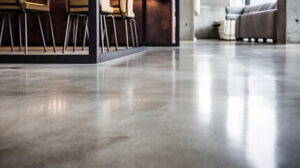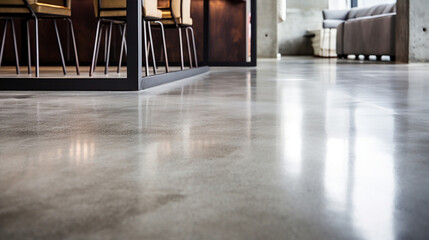Concrete polishing has become a hot trend in commercial and industrial spaces. It is a low-maintenance option that provides durability, visual appeal and sustainability.
Its reflective surface enhances lighting and attracts customers, while its durability withstands heavy foot traffic. The sanitary nature of polished concrete makes it ideal for warehouses, retail stores, food service areas and car showrooms. Contact Polished Concrete Orange County for professional help.
Concrete polishing transforms dull and unattractive concrete floors into high-gloss, mirror-like surfaces that enhance the aesthetics of your business or residential space. This process also gives the concrete a protective sealer that improves its durability and stain resistance. The resulting surface can be customized to your desired sheen level, from a soft matte to a reflective shine. It can also be enhanced with aggregates, dyes, and stamped patterns that mimic marble or tile. This versatility in aesthetics makes polished concrete an excellent choice for open-concept spaces, where it can adapt to a wide range of design styles.
There are several different types of finishes for polished concrete, ranging from a creamy finish to an exposed aggregate look. The concrete densifier used to cure the concrete can impact the final look. For example, a sodium silicate densifier produces a higher sheen than calcium silicate densifiers, which produce a lower sheen. Depending on the type of sheen desired, you may need to perform additional steps to achieve the finish you want.
For example, a concrete densifier can be used to create a salt and pepper finish that exposes fine sands or coarser aggregates. You can also choose to add a color to the densifier to create a colored concrete finish. A broom finish is another option, in which the floor is lightly swept and then damp mopped with a neutral pH cleaner.
Aside from enhancing the aesthetics of your building, polished concrete is easy to maintain and lasts longer than alternative flooring options. It is ideal for commercial and industrial facilities that require a durable surface that can handle heavy foot traffic, forklifts, and vehicle traffic. Additionally, it is an excellent choice for retail locations, warehouses, and showrooms.
Moreover, the concrete’s reflectivity increases ambient lighting in the facility, which reduces energy costs and improves indoor air quality. This feature is especially helpful in large warehouses, where natural lighting is often limited. In addition, the concrete’s chemical resistance makes it a good choice for distribution centers, factories, and other industrial settings.
Lastly, polished concrete is an affordable alternative to other floor coverings. It requires less maintenance and is easier to clean than rugs or carpets, making it a cost-effective solution for many businesses. Moreover, it is environmentally friendly, as it uses the existing concrete slab and does not use harmful chemicals.
Durability
Polished concrete is a popular floor choice for both commercial and residential applications, offering a sleek and stylish alternative to traditional flooring materials. While it is an excellent option for high-traffic areas, it is important to consider the durability of polished concrete before making a purchase. The following questions will help you determine whether this solution is right for your space:
The concrete mix design, proper installation methods and adequate curing time are all factors that affect the durability of a polished concrete floor. When the proper procedures are followed, a concrete floor will be extremely durable and long-lasting. The best way to ensure that your new polished concrete floors will last is to have them professionally installed by a trained professional.
Unlike a typical grind and seal finish, a polished concrete floor requires a lengthy process of grinding the concrete with increasingly finer diamond discs and applying chemical hardeners in between each step. This makes it more expensive than a standard grind and seal, but it also means that your finished product will be more durable.
To get the most out of your investment in a polished concrete floor, it is important to discuss your desired outcome with your contractor before beginning the work. This will ensure that the finished product meets your expectations, including any specifications for trowel marks, sheen level and aggregate exposure.
The use of a chemical hardener will improve the concrete’s surface, making it more resistant to stains and other damage. However, it is not impervious to scratches. It is still important to maintain a regular cleaning routine, such as sweeping or dust mopping daily, and placing doormats at entryways to catch dirt before it hits the floor.
Another factor to consider is that polished concrete is cold underfoot, especially in cooler climates. This can lead to a lack of comfort and may require additional considerations such as radiant heat systems or the use of rugs.
Stain resistance
Concrete, by nature, is a porous material. Without protection, unpolished concrete is prone to staining from chemicals, oils and food-based liquids. As a result, stained concrete and polished concrete are popular choices for areas that need to be resistant to spills and messes, such as commercial kitchens and retail spaces. With a proper polishing and sealer, the pores in the concrete are closed, making it impossible for liquids to penetrate and cause damage.
However, it is important to note that no surface is completely impervious to staining. Proper cleaning and maintenance are the key to preventing and reversing damage to any surface, including polished concrete. To enhance the stain resistance of your concrete, consider adding a silicate densifier to the mix before polishing. Silicate densifiers bond with the concrete to fill any voids with a silica mixture, dramatically reducing its porosity and strengthening it, thereby increasing its stain resistance.
Another option is to use a hybrid sealer. These sealers combine the properties of penetrating and film-forming sealers, creating a layered system of protection for your concrete. These sealers help to protect the surface from staining, while also enhancing its appearance. Additionally, you may want to consider using a color-enhancing or UV-resistant sealer on your concrete floor to prevent yellowing and discoloration over time.
Regardless of which product you choose, regular maintenance will greatly aid in preserving the life of your polished concrete flooring. Sweep the floors regularly to remove dust and debris from the surface. Damp mop the floors with a clean water solution as needed, typically with a citrus based pH neutral cleaner, or as directed by your ACC professional.
While polished concrete is an excellent choice for high traffic and use areas, it is not a good choice for areas that require a high level of foot traction. If you require additional slip resistance, a non-slip additive can be added to the concrete prior to polishing. This is an inexpensive option that will significantly increase the safety of your floor while still maintaining its visual appeal. Lastly, resealing your polished concrete on an annual basis will keep it looking its best.
Maintenance
Concrete floors need a lot of maintenance in order to look their best. This is especially true of Polished Concrete, which requires a special technique to create a polished surface and prevent the floor from becoming damaged. By avoiding certain common mistakes and following the best practices, your polished concrete can last for years to come and maintain its beautiful sheen.
Grit buildup is the most common cause of damage to polished concrete. It’s important to regularly sweep the concrete with a bristle broom and vacuum frequently in order to keep the grit to a minimum. It’s also helpful to install entryway mats in high traffic areas and encourage people to wipe their shoes before entering the space. This will minimize the amount of outside debris that is tracked into the space, particularly in cold weather climates where de-icing salt is often used. It’s a good idea to use textile walk-off mats in high traffic areas to further minimize the impact of tracked in debris on your polished concrete.
It’s also recommended to use a neutral pH cleaner formulated specifically for use on polished concrete flooring. Acidic cleaners wear away the sealer, leaving the floor vulnerable to damage and staining. If a spill does occur, it’s essential to clean up the area immediately with water and the recommended cleaner.
A regular cleaning program of the concrete floor will keep it looking and functioning as if it was just installed. This should be done with an automatic scrubber outfitted with pads designed for polished concrete. If the floor is stained or contaminated, it should be cleaned with a mop and water, or a soft nylon-bristle brush or neoprene squeegee. Abrasion wear is reduced by using a non-slip pad on the mop.
A professional may be able to advise on the most appropriate method of maintaining your concrete floors and recommend the best products and frequency of use. Most importantly, a professional can determine whether your floor needs to be resealed. Resealing is required every few years to protect the floor and ensure it retains its shine.

